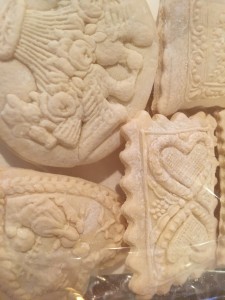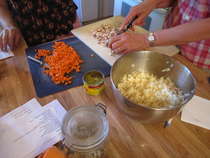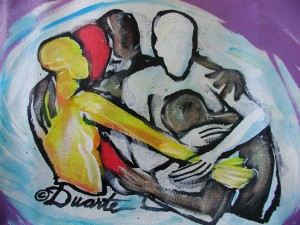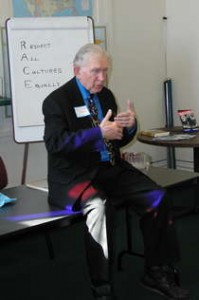
PHOTO: Mary van Balen
Originally published in The Catholic Times, February 12, 2017
On my way to work, I stopped at the Cambridge Tea House to buy a currant scone. The crusty outside is just sweet enough and surrounds a tender center filled with currants. No jam needed. I prefer mine just as they come out of the oven, and when I’m early, they’re still warm.
Waiting for the young woman at the counter to ring up the purchase, I noticed small packages of intricately stamped springerele cookies resting on a glass plate. My daughter and I bake a few hundred each Christmas. Ours are anise flavored and decorated with bells and angels, but these were smaller, almond flavored, and covered with flowers and hearts for Valentine’s Day.
“They’re beautiful,” I said as the tea house owner and baker emerged from the kitchen.
“A local woman makes them,” she volunteered. I picked up one of the clear bags for a closer look. “The recipe’s 150 years old.”
I wondered aloud if she used baker’s ammonia or some other leavening.
“What’s baker’s ammonia? the younger woman asked.
So began the story. I told them about baking springereles using an old family recipe from a friend of my mother. “Baker’s ammonia is used in many old recipes. I used to buy it at pharmacies, but it’s more difficult to find now. You can order it online.” I described our technique that evolved from using a traditional wooden board carved with designs that we pressed into the dough to our current biscuit cutter/cookie stamp routine.
“After we cut and stamp the cookies, we spread them over the counter to dry overnight. Baker’s ammonia is heat activated, so they form a crusty top that keeps the stamped impression crisp when it bakes.”

PHOTO: Mary van Balen
As the story unwound, the three of us stood still, caught up not only in my story, but in the personal stories it evoked in each of us. Images from deep heart-places, rising to the surface, pulling along sights, sounds, smells, and emotion as they broke into consciousness. In silence, we breathed stories.
We recognized them in each other’s eyes, memories both unique and the same: delight in the preparation and sharing of special foods with loved ones, anguish faced over steaming cups of tea and coffee, or reverence before moments of grace when the veil of ordinariness slipped away revealing the extraordinary that’s always present.

Painting by Richard Duarte Brown
Motionless, we paused, heartened by our connection. There we were, members of one family, God’s beloved community.
We should give thanks for the humble story, for the telling that reminds us of the basic connection of all human beings. It isn’t “them and us” as some would have us believe. “Other” is a fiction. Really, at the core, we are much the same. How to remember this in times of division?
Sharing story is one way, the ancient sacrament as old as humanity. Sometimes the details are unfamiliar: Details of lives lived as a part of the minority or of the privileged majority; details of living in poverty or in wealth; details of raising children or living as a single person; details of enjoying good health or suffering physical or mental illness. The list is endless.
But, if we listen to the stories of people who at first glance are “not like us,” we recognize common threads: Courage. Fear. Love and need for it. Desire to care for our children. To have enough to eat. The search for meaning and self-expression, acceptance and reverence.

PHOTO: Mary van Balen
Rev. Robert Graetz telling his story of the Montgomery Bus Boycott and current civil rights issues to a class of adult learners in the Even Start Program and their guests
There are many stories we need to hear today from people both within and outside our usual circles: stories of people who think like us and those who don’t. People dealing with uncertainties of jobs and homes. There are stories of refugees, undocumented immigrants, ethnic and racial minorities, indigenous people, LGBT people, those who are abused.
Their stories cry out to be heard. Sometimes stories are told in books like “Hidden Figures” and film like the movie “Lion.” An Oscar nominated documentary on James Baldwin, “I Am Not Your Negro,” was released last week, and from reviews I’ve read, it’s filled with stories that can help us better understand race in our country.
Jesus used the power of story, moving his listeners to open their hearts to the stranger, to follow his example, to love. Story has the power to break barriers, to unite, to give heart, to change history. Or, less lofty, to shine the warm light of common humanity on an ordinary morning trek to work.
©2017 Mary van Balen
